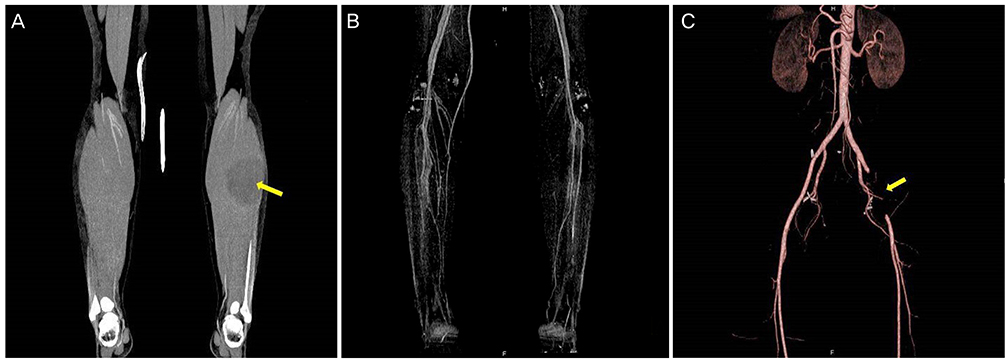Obstet Gynecol Sci.
2017 Mar;60(2):223-226. 10.5468/ogs.2017.60.2.223.
Lower limb compartment syndrome by reperfusion injury after treatment of arterial thrombosis post-laparoscopic radical hysterectomy and pelvic lymph node dissection for cervical cancer
- Affiliations
-
- 1Department of Obstetrics and Gynecology, Chungnam National University Hospital, Daejeon, Korea. bell4184@cnuh.co.kr
- 2Department of Surgery, Yeungnam University Medical Center, Daegu, Korea.
- KMID: 2372809
- DOI: http://doi.org/10.5468/ogs.2017.60.2.223
Abstract
- Compartment syndrome is a clinical condition associated with decreased blood circulation that can lead to swelling of tissue in limited space. Several factors including lithotomy position, prolonged surgery, intermittent pneumatic compressor, and reperfusion after treatment of arterial thrombosis may contribute to compartment syndrome. However, compartment syndrome rarely occurs after gynecologic surgery. In this case, the patient was diagnosed as compartment syndrome due to reperfusion injury after treatment of arterial thrombosis, which occurred after laparoscopic radical hysterectomy and pelvic lymph node dissection for cervical cancer. Despite its rarity, prevention and identifying the risk factors of complication should be performed perioperatively; furthermore, gynecologist should be aware of the possibility of complications.
MeSH Terms
Figure
Reference
-
1. Radosa JC, Radosa MP, Sutterlin M. Acute lower limb compartment syndrome after cesarean section: a case report. J Med Case Rep. 2011; 5:161.2. Bauer EC, Koch N, Janni W, Bender HG, Fleisch MC. Compartment syndrome after gynecologic operations: evidence from case reports and reviews. Eur J Obstet Gynecol Reprod Biol. 2014; 173:7–12.3. Wassenaar EB, van den Brand JG, van der Werken C. Compartment syndrome of the lower leg after surgery in the modified lithotomy position: report of seven cases. Dis Colon Rectum. 2006; 49:1449–1453.4. Nakamura K, Aoki H, Hirakawa T, Murata T, Kanuma T, Minegishi T. Compartment syndrome with thrombosis of common iliac artery after gynecologic surgery. Obstet Gynecol. 2008; 112:486–488.5. Cohen SA, Hurt WG. Compartment syndrome associated with lithotomy position and intermittent compression stockings. Obstet Gynecol. 2001; 97:832–833.6. Tomassetti C, Meuleman C, Vanacker B, D'Hooghe T. Lower limb compartment syndrome as a complication of laparoscopic laser surgery for severe endometriosis. Fertil Steril. 2009; 92:2038.e9–2038.e12.7. Yanazume S, Yanazume Y, Iwamoto I, Tsuji T, Yoshinaga M, Douchi T. Severe leg compartment syndrome associated with dorsal lithotomy position during radical hysterectomy. J Obstet Gynaecol Res. 2006; 32:610–612.8. Boesgaard-Kjer DH, Boesgaard-Kjer D, Kjer JJ. Well-leg compartment syndrome after gynecological laparoscopic surgery. Acta Obstet Gynecol Scand. 2013; 92:598–600.9. Previtali E, Bucciarelli P, Passamonti SM, Martinelli I. Risk factors for venous and arterial thrombosis. Blood Transfus. 2011; 9:120–138.10. Orlin JR, Oen J, Andersen JR, Tjugum IJ, Westbye HJ, Roska J, et al. Leg cramps in pregnancy caused by chronic compartment syndrome and relieved by fasciotomy after childbirth. Clin Case Rep. 2014; 2:103–107.11. Bauer EC, Koch N, Erichsen CJ, Juettner T, Rein D, Janni W, et al. Survey of compartment syndrome of the lower extremity after gynecological operations. Langenbecks Arch Surg. 2014; 399:343–348.
- Full Text Links
- Actions
-
Cited
- CITED
-
- Close
- Share
- Similar articles
-
- The Urologic Complications following Radical Hysterectomy with Pelvic Lymph node Dissection
- Chylous ascites, following radical hysterectomy with pelvic lymph node dissection in a patient with cervical cancer
- A study on post-operative complications of radical abdominal hysterectomy with pelvic lymph node dissection
- Postoperative adjuvant CCRT concurrentchemoradiotherapy for selected early stage cervical cancer patients following radical hysterectomy and pelvic lymph node dissection
- Laparoendoscopic single-site radical hysterectomy for early stage cervical cancer


